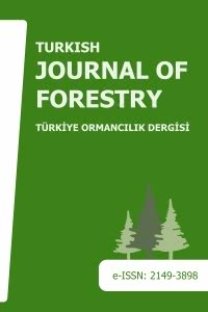Tarsus yöresi makromantarları ve ektomikorizalar
ektomikoriza, Türkiye, kültür mantarı, makrofungi
Macrofungi of Tarsus district and ectomycorrhizas
ectomycorrhizas, Turkey, mushrooms, macrofungi,
___
- Akman, Y., 1999. İklim ve biyoiklim. Kariyer Matbaacılık Ltd., Ankara.
- Arnolds, E., 1993. Problems in Measurements of Species Diversity of Macrofungi (Ed.by E.Allsopp, R.R.Colwell, D.L.Hawksworth, Microbial Diversity and Ecosystem Function), CAB International, UNEP, 337-354, London, UK
- Breitenbach, J., Kränzlin, F., 1984-2000. Fungi of Switzerland, vols. 1-6. Lucerne: Verlac Mykologia.
- Chang, S. T., 1999. World production of cultivated edible and medicinal mushrooms in 1997 with emphasis on Lentinus edodes (Berk.) Sing. in China. International J. Med. Mush., 1: 291–300.
- Doğan, H.H., Aktaş, S., Öztürk, C., Kaşık, G., 2012. Macrofungi distribution of Cocakdere valley (Arslanköy, Mersin). Turk J Bot. 36: 83-94.
- Gemici, Y., 1993. Bolkar dağları’nın (Orta Toroslar) flora ve vejetasyonu üzerine genel bilgiler. Tr. J. of Bot., 18: 81-89.
- Hall, R.I., Stephenson,,S.L., Buchanan, P.K., Yun, W. and Cole, A.L.J. 2003. Edible and poisonous mushrooms of the world, Timber Pres, 371 p. Portland, Cambridge.
- Huffman, D.M., Tiffany, L.H., Knaphus, G. and Healy and L.A. 2008. Mushrooms and other fungi of the Midcontinental United States, Second Edition, University of Iowa Press, 385 p., USA.
- Işıloğlu, M. 1992. Adana ve İçel il sınırlarında yetişen önemli yenen ve zehirli mantarlar üzerindeki taksonomik araştırmalar, S.Ü.Fen Bilimleri Enstitüsü Doktora Tezi, 125 p., Konya.
- Işıloğlu, M. and Öder, N., 1995. Contributions to the macrofungi of Mediterranean Turkey. Turk J. Bot. 19: 603-609.
- Kaşık, G., Öztürk, C,. Türkoğlu, A., Doğan, H.H., 2003. Macrofungi of Yahyalı (Kayseri) Province. Turk J. Bot. 27: 453-462.
- Kaya, A., Akan,Z., Demirel,K., 2004. Checklist of Macrofungi Besni (Adıyaman) District. Turk J Bot 28: 247-251.
- Kaya, A. 2006. Macrofungi Determined in Andırın District. Turk J Bot 30: 85- 93.
- Kaya, A., Uzun, Y., Karacan, İ.H., 2009. Macrofungi of Göksun (Kahramanmaraş) district. Turk J Bot 33: 131-139.
- Lakhanpal, T.N., 2000. Ectomycorrhiza-An Overview, In:Mycorrhizal Biology, (Ed.by K.G.Mukerji, B.P.Chamola, J.Singh), Kluwer Academic, 101-118.
- Landecker, E. M., 1996. Fundamentals of The Fungi, Prentice Hall, Upper Saddle River, New Jersey.
- Malajczuk, N., Groven, T.S., Thomson, B.T., Bougher, N.L., Tommerup, I., Kuek, C and Dell, B. 1992. Ectomycorrhizas.In: Microorganisms that Promote Plant Productivity. Kluwer Press, Amsterdam.
- Marschner, H., 1995. Mineral Nutrition of Plants, 2nd ed., Academic Press, London, UK.
- Mat, A., 1997. Türkiye’de Mantar Zehirlenmeleri Zehirli Mantarlar, Tübitak Başvuru Kitapları, 183 s., Ankara.
- Mc Carthy, J., 2001. Gap Dynamics of Forest Trees: A Rewiev with Particular Attention to Boreal Forests, Environ., Rev. 9, 209-220.
- Mehus, H., 1986. Fruit Body Production of Macrofungi in Some North Norwegian Forest Types, Nords. J.Bot., 6: 679-702.
- Miller, O.K. and Miller, H.H. 1988. Gasteromycetes. Eureka: Mad River Press.
- Molina, R., Massicotte, H., Trappe, J.M., 1992. Specificity Phenomena in Mycorrhizal Symbioses: Community-Ecological Consequences and Practical Implications, (Ed.M.F.Allen), Chapman and Hall, Inc. NY
- Moser, M., 1983. Keys to Agarics and Boleti. Stuttgart: Gustav Fischer Verlag.
- Ohenoja, E., 1993. Effect of Weather Conditions on the Larger Fungi at Different Forest Sites in Northern Finland in 1976- 1988, Acta Universitatis Ouluensis, series A, 243.
- Phillips, R., 1981. Mushrooms and other fungi of Great Britain and Europe. London: Pan Books Ltd.
- Read, D.J., 1984.: The Structure and Function of the Vegetative Mycelium of Mycorrhizal Roots, In: The Ecology and Physiology of the Fungal Mycelium, (Eds. D.H.Jennings and A.D.M.Rayner), British Mycological Society Symposium 8, Cambridge University Press, pp. 215-40, London.
- Smith, S.E., Read, D.J., 1997. Mycorrhizal Symbiosis, Second Edition, Academic Pres Ltd., 605 p., Cambridge, UK.
- Russell, B., 2006. Field guide to wild mushrooms of Pennsylvania and the Mid-Atlantic, the Pennsylvania State University Press, 249 p., USA.
- Tüfekçi,S., Ortaş,İ., Özkurt ,N., 2006. Bolkar Dağları Doğal Kızılçam (Pinus brutia Ten.) Meşcerelerinde Mikorizal Mantarların Tespiti ve Aşılama Uygulaması, Doğu Akdeniz Ormancılık Araştırma Enstitüsü Teknik Bülten No: 26, 30 s. Tarsus.
- ISSN: 1302-7085
- Yayın Aralığı: Yılda 2 Sayı
- Başlangıç: 2000
Sandalye çerçevelerinin sonlu elemanlar analizi
TUĞBA YILMAZ AYDIN, Ergün GÜNTEKİN
Artvin ilinde doğal çevrenin kent kimliğine etkileri
HİLAL TURGUT, AYŞE YAVUZ ÖZALP, Aslıhan ERDOĞAN
RAMAZAN ÖZÇELİK, HAKKI YAVUZ, YASİN KARATEPE, NEVZAT GÜRLEVİK, Rüstem KIRIŞ
Isıl işlemin meşe (Quercus petraea L.) ağaç malzemede yapışma direncine etkileri
Kızılçam (Pinus brutia Ten.) kerestesi için direnç sınıflandırması
Ergün GÜNTEKİN, TUĞBA YILMAZ AYDIN
Göller yöresinde yalancı akasya, Anadolu karaçamı ve toros sediri ağaç türleri için çap-boy modeli
Kayın, kavak ve okaliptüs kaplamalarından üretilen kontrplakların bazı fiziksel özellikleri
Bekir Cihad Bal, İBRAHİM BEKTAŞ
Taksonomik çeşitlilik indislerinin geleneksel çeşitlilik indisleri ile karşılaştırılması
Tomrukların bölmeden çıkarılmasında tokk-m sisteminin uygulanması
